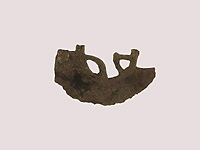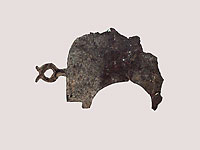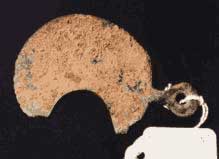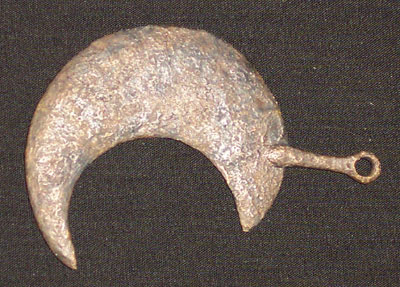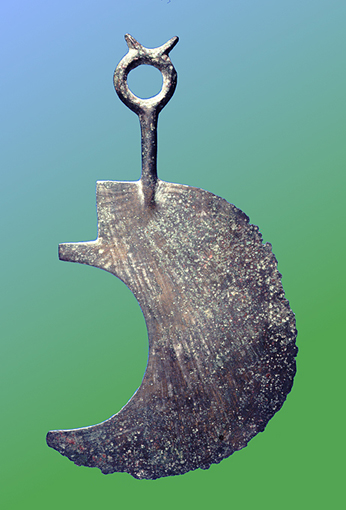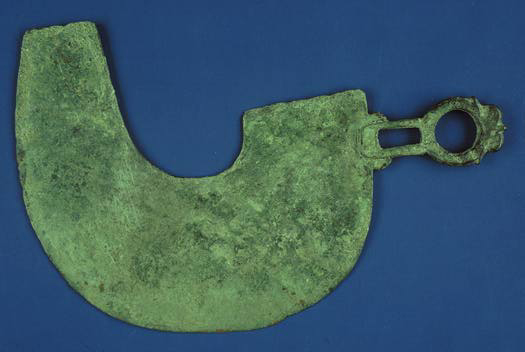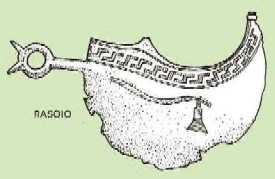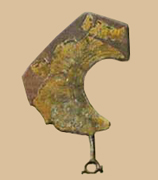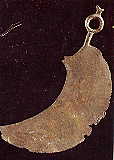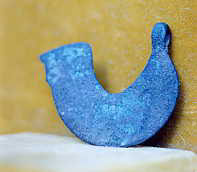|
Rasoirs du passé
|
Razors through the past | ||
|
Forme
Croissant de
lune / Half-moon shape 1er page
|
|||
|
Musée de Sainte-Bazeille Fragment de rasoir en forme de croissant de lune, lame plate, ajouré sur sa partie supérieure. http://www.lot-et-garonne.fr/html/archeo/html/911.htm |
|||
|
|
Type d'objet :
Domestique.
Matière :Métallique. Bronze
|
||
|
Rasoir dit “Villanovien”. Large lame plate en croissant de lune amincie vers la pointe, dotée d'un court manche annelé décoré de deux petits ergots. http://www.cg47.fr/html/archeo/html/416.htm |
|||
|
|
Type d'objet :
Domestique. Matière : Métallique. Bronze Chronologie : Bronze final. Phase Bologne II ou Este II (800-700 av. J.-C., d'après Müller Karpe) Dimensions : long. 11,9 cm - larg. 7,6 cm - ép. 0,5 cm - diam. anneau 1,9 cm. Lieu de conservation : Musée d'Agen Etat de conservation : Tranchant ébréché, corrosion. Provenance : Cornetto (Etrurie) |
||
|
CLARK COLLECTION OF ANCIENT ART |
|||
|
|
Culture: Villanovan Item: Bronze razor Date: 8th century BCE Description: Lunate razor with eyelet pommel. For similar razor types see V. Bianco Peroni, PB, Sect. 8 Vol. 2: I rasoi nell'Italia continentale (Munich 1979) 123, 124, 127, 135 ns. 743, 747, Grotta Gramiccia Type Variety A, 8th century BCE; H. Hencken, Tarquinia, Villanovans, and Early Etruscans Villanovan IC-IIB periods.
|
||
|
Etruscan and Greek Antiquities http://www.wallisartgallery.gq.nu/catalog.html |
|||
|
|
Italic
Bronze Razor
- INTACT and SHARP!!!
Here for your consideration is a wonderfully intact and sharp early Italic bronze razor with a small handle and suspension loop. Measures: 70 mm in length. |
||
|
THE ETRUSCAN SECTION http://www.comune.bologna.it/bologna/Musei/Archeologico/etruschi/en/6a_e.htm |
|||
|
|
During the Villanovan period, the principal funerary rites was cremation: the body was burned and ashes were gathered inside an urn, the biconic urn, laid in the tomb together with others burial items. In the earliest phase (9th century BC) the urn was put in a shaft, tipically covered with pebbles and slabs, with a few objects: a bronze razor for men and spinning tools (spindles-whorls and spools ) for women; fibulae of different shapes according to sex of the dead person, are also very common. | ||
